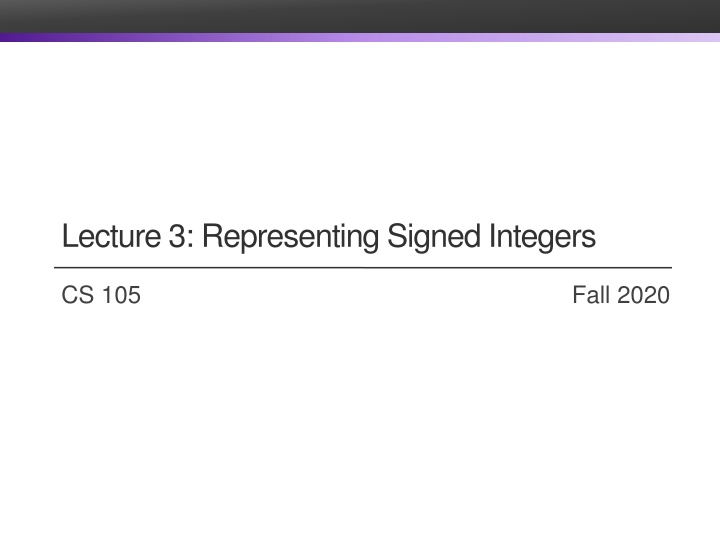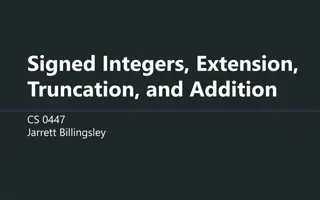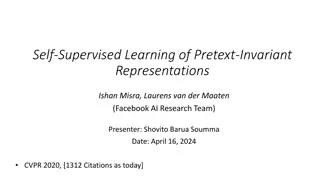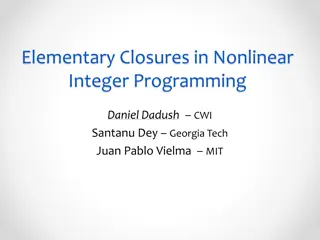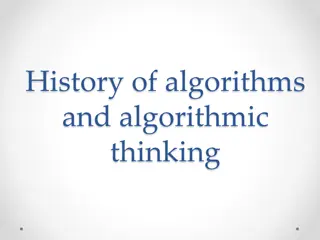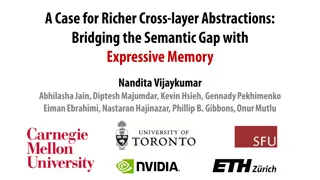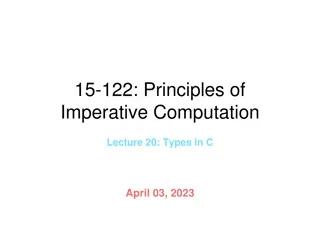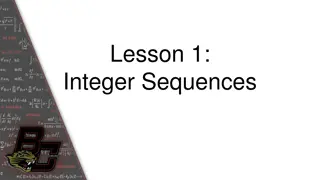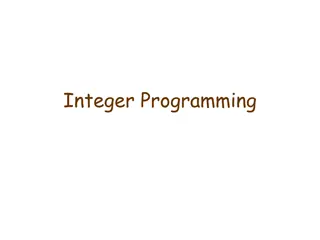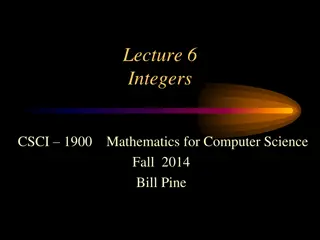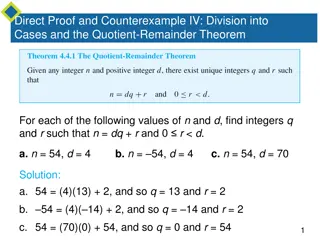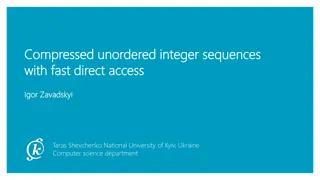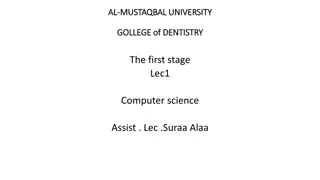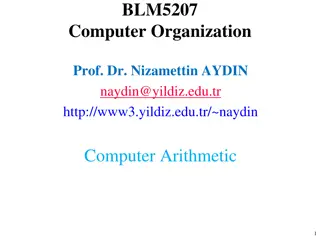Signed Integer Representations in Computer Science
Explore various methods of representing signed integers in computer memory, including sign-magnitude, excess-K, and two's complement. Learn about binary numbers, important signed values, and how to perform calculations with signed integers. Delve into exercises to solidify your understanding.
Download Presentation

Please find below an Image/Link to download the presentation.
The content on the website is provided AS IS for your information and personal use only. It may not be sold, licensed, or shared on other websites without obtaining consent from the author.If you encounter any issues during the download, it is possible that the publisher has removed the file from their server.
You are allowed to download the files provided on this website for personal or commercial use, subject to the condition that they are used lawfully. All files are the property of their respective owners.
The content on the website is provided AS IS for your information and personal use only. It may not be sold, licensed, or shared on other websites without obtaining consent from the author.
E N D
Presentation Transcript
Lecture 3: Representing Signed Integers CS 105 Fall 2020
Memory: A (very large) array of bytes bytes Memory is an array of bits 1 1 1 0 00110111 1 A byte is a unit of eight bits 1 0 0 3 1 0 0 0 An index into the array is an address, location, or pointer Often expressed in hexadecimal 11010001 1 0 1 1 2 1 1 0 0 We speak of the value in memory at an address The value may be a single byte or a multi-byte quantity starting at that address 01010011 1 0 1 0 1 0 0 1 1 01101100 0 1 1 0 0
Base-2 Integers (aka Binary Numbers) 128 (27) 64 (26) 32 (25) 16 (24) 8 (23) 4 (22) 2 (21) 1 (20) 0 0 0 0 0 1 0 1 0 0 1 0 1 1 1 1 1 1 1 1 1 1 1 1
4 Representing Signed Integers Option 1: sign-magnitude One bit for sign; interpret rest as magnitude +/- 64 (26) 32 (25) 16 (24) 8 (23) 4 (22) 2 (21) 1 (20) - 0 0 0 0 0 1 0 1 1 0 0 0 0 1 0 1
5 Representing Signed Integers Option 2: excess-K Choose a positive K in the middle of the unsigned range SignedValue(w) = UnsignedValue(w) K 128 (27) 64 (26) 32 (25) 16 (24) 8 (23) 4 (22) 2 (21) 1 (20) -128 0 0 0 0 0 1 0 1 1 0 0 0 0 1 0 1
6 Representing Signed Integers Option 3: two s complement Most commonly used Like unsigned, except the high-order contribution is negative ?????? ? = ?? 1 2? 1+ ?=0 -128 (-26) 64 (26) 32 (25) 16 (24) ? 2?? 2? 8 (23) 4 (22) 2 (21) 1 (20) 0 0 0 0 0 1 0 1 1 1 1 1 1 0 1 1 1 1 1 1 1 1 1 1
8 Example: Three-bit integers
Important Signed Numbers 8 16 32 64 TMax TMin 0 -1 0x7F 0x7FFF 0x7FFFFFFF 0x7FFFFFFFFFFFFFFF 0x80 0x8000 0x80000000 0x8000000000000000 0x00 0x0000 0x00000000 0x0000000000000000 0xFF 0xFFFF 0xFFFFFFFF 0xFFFFFFFFFFFFFFFF
10 Exercise 1: Signed Integers Assume an 8 bit (1 byte) signed integer representation: What is the binary representation for 47? What is the hex representation for 47? What is the binary representation for -47? What is the hex representation for -47
11 Exercise 1: Signed Integers Assume an 8 bit (1 byte) signed integer representation: What is the binary representation for 47? What is the hex representation for 47? What is the binary representation for -47? What is the hex representation for -47 00101111 0x2F 11010001 0xD1
Casting between Numeric Types Casting from shorter to longer types preserves the value Casting from longer to shorter types evaluates to ?2??(? mod 2?) Casting between signed/unsigned types preserves the bits (it just changes the interpretation) Implicit casting occurs in assignments and parameter lists. In mixed expressions, signed values are implicitly cast to unsigned Source of many errors!
Exercise 2: Casting Assume you have a machine with 6-bit integers/3-bit shorts Assume variables: int x = -17; short sy = -3; Complete the following table Expression Decimal -6 Binary 101010 (unsigned int) x (int) sy TMax TMin
Exercise 2: Casting Assume you have a machine with 6-bit integers/3-bit shorts Assume variables: int x = -17; short sy = -3; Complete the following table Expression Decimal -6 -22 47 -3 31 -32 Binary 111010 101010 101111 111101 011111 100000 (unsigned int) x (int) sy TMax TMin
15 When to Use Unsigned Rarely When doing multi-precision arithmetic, or when you need an extra bit of range but be careful! unsigned i; for (i = cnt-2; i >= 0; i--){ a[i] += a[i+1]; }
Arithmetic Logic Unit (ALU) circuit that performs bitwise operations and arithmetic on integer binary types
17 Bitwise vs Logical Operations in C Bitwise Operators &, |, ~, ^ View arguments as bit vectors operations applied bit-wise in parallel Logical Operators &&, ||, ! View 0 as False View anything nonzero as True Always return 0 or 1 Early termination Shift operators <<, >> Left shift fills with zeros For signed integers, right shift is arithmetic (fills with high-order bit)
18 Exercise 3: Bitwise vs Logical Operations Assume signed one-byte integer values ~0xe2 !0xe2 0x78 & 0x55 0x78 | 0x55 0x78 && 0x55 0x78 || 0x55 0x96 << 4 0x96 << 2 0x96 >> 4 0x96 >> 2
19 Exercise 3: Bitwise vs Logical Operations Assume signed char data type (one byte) = ~11100010 = 00011101 = 0x1d ~0xe2 !0xe2 = !11100010 = 00000000 = 0x00 = 01111000 & 01010101 = 01010000 = 0x50 0x78 & 0x55 = 01111000 | 01010101 = 01111101 = 0x7d 0x78 | 0x55 0x78 && 0x55 0x78 || 0x55 = 01111000 && 01010101 = 00000001 = 0x01 = 01111000 || 01010101 = 00000001 = 0x01 = 10010110 << 4 = 01100000 = 0x60 = 10010110 << 2 = 01011000 = 0x58 = 10010110 >> 4 = 00001001 = 0x09 = 10010110 >> 2 = 00100101 = 0x25 0x96 << 4 0x96 << 2 0x96 >> 4 0x96 >> 2
Addition Example Compute 5 + -3 assuming all ints are stored as four-bit signed values 1 1 1 1 0 1 0 1 0 1 0 1 + 1 1 0 1 + 1 1 0 1 0 0 0 0 0 0 1 1 = 2 (Base-10) Exactly the same as unsigned numbers! but with different error cases
Addition/Subtraction with Overflow Compute 5 + 3 assuming all ints are stored as four-bit signed values 1 1 1 1 1 1 0 1 0 1 0 1 0 1 + 0 0 1 1 + 0 0 1 1 0 0 1 1 0 0 0 0 = -8 (Base-10)
Error Cases Assume ?-bit signed values 2? 1 2 2? 1 2? 1 2 2? 1 0 [ ) representable values ( ) Possible values of ? + ? ? + ? 2? (positive overflow) ? + ? ? + ? + 2? (negative overflow) ?? = (normal) ? +? overflow has occurred iff ? > 0 and y > 0 and ? +? or ? < 0 and y < 0 and ? +? ?? < 0 ?? > 0
Exercise 4: Binary Addition Given the following 5-bit signed values, compute their sum and indicate whether or not an overflow occurred x y x+y overflow? 00010 01100 10100 00101 00100 10001
Exercise 4: Binary Addition Given the following 5-bit signed values, compute their sum and indicate whether or not an overflow occurred x y x+y overflow? no 00010 01100 10100 00101 00100 10001 00111 10000 00101 yes yes
Multiplication Example Compute 3 x 2 assuming all ints are stored as four-bit signed values 0 0 1 1 0 0 1 1 x 0 0 1 0 x 0 0 1 0 0 0 0 0 0 0 0 0 + _ + _ 0 0 1 1 0 0 1 1 0 0 0 1 1 0 0 1 1 0 = 6 (Base-10) Exactly like unsigned multiplication! except with different error cases
Multiplication Example Compute 5 x 2 assuming all ints are stored as four-bit signed values 0 1 0 1 0 1 0 1 x 0 0 1 0 x 0 0 1 0 0 0 0 0 0 0 0 0 0 1 0 1 0 1 0 1 0 0 + _ + _ 1 0 1 0 1 0 1 0 = -6 (Base-10)
Error Cases Assume ?-bit unsigned values 2? 1 2? 1 22(? 1) 22(? 1) 0 [ ) representable values [ ) Possible values of ? ? ?? = ?2?( ? ? mod 2?) ? ?
Exercise 5: Binary Multiplication Given the following 3-bit signed values, compute their product and indicate whether or not an overflow occurred x y x*y overflow? 100 010 111 101 011 010
Exercise 5: Binary Multiplication Given the following 3-bit signed values, compute their product and indicate whether or not an overflow occurred x y x*y 100 110 110 overflow? yes 100 010 111 101 011 010 yes yes
30 Multiplying with Shifts Multiplication is slow Bit shifting is kind of like multiplication, and is often faster x * 8 = x << 3 x * 10 = x << 3 + x << 1 Most compilers will automatically replace multiplications with shifts where possible
31 Signed Division by a Power of 2 x >> k computes x / 2k (rounded towards ) -12 >> 2 = 11110100 >> 2 = 11111101 = -3 C on Intel processors rounds towards 0 -11 >> 2 == -3, but -11/4 == -2 Solution: If x < 0, add 2k-1 before shifting if (x < 0){ x += (1 << k) 1; } return x >> k;
Exercise 6: Feedback 1. Rate how well you think this recorded lecture worked 1. Better than an in-person class 2. About as well as an in-person class 3. Less well than an in-person class, but you still learned something 4. Total waste of time, you didn't learn anything 2. How much time did you spend on this video lecture (including time spent on exercises)? 3. Do you have any comments or feedback?
